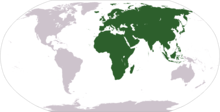Old World
This article needs additional citations for verification. (March 2013) |

Old World
Ptolemy world map
in a 15th-century copy)
The "Old World" (
Latin: Mundus Vetus) is a term for Afro-Eurasia that originated in Europe after 1493, when Europeans became aware of the existence of the Americas.[1] It is used to contrast the continents of Africa, Europe, and Asia in the Eastern Hemisphere, previously thought of by their inhabitants as comprising the entire world, with the "New World", a term for the newly encountered lands of the Western Hemisphere, particularly the Americas.[2] While located closer to Afro-Eurasia within the Eastern Hemisphere, Australia is considered neither an Old World nor a New World land, since it was only discovered by Europeans after the distinction had been made; both Australia and Antarctica were associated instead with the Terra Australis
that had been posited as a hypothetical southern continent.
Etymology
In the context of
.These regions were connected via the
cultural spheres
.
Other names
The
Halford John Mackinder in The Geographical Pivot of History.[3]
References
- ^ "Old World". Merriam-Webster Dictionary. Archived from the original on 2 April 2019. Retrieved 3 December 2014.
- ^ "New world". Merriam-Webster Dictionary. Archived from the original on 2 April 2019. Retrieved 2 April 2013.
- ^ See Francis P. Sempa, "Mackinder's World" Archived 3 March 2016 at the Wayback Machine. American Diplomacy (UNC.edu). Retrieved 8 September 2018.
